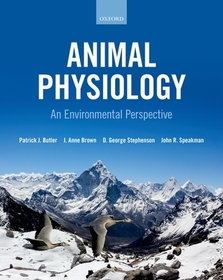
Animal Physiology: an environmental perspective
-
10% KEDVEZMÉNY?
- A kedvezmény csak az 'Értesítés a kedvenc témákról' hírlevelünk címzettjeinek rendeléseire érvényes.
- Kiadói listaár GBP 70.99
-
33 915 Ft (32 300 Ft + 5% áfa)
Az ár azért becsült, mert a rendelés pillanatában nem lehet pontosan tudni, hogy a beérkezéskor milyen lesz a forint árfolyama az adott termék eredeti devizájához képest. Ha a forint romlana, kissé többet, ha javulna, kissé kevesebbet kell majd fizetnie.
- Kedvezmény(ek) 10% (cc. 3 392 Ft off)
- Kedvezményes ár 30 524 Ft (29 070 Ft + 5% áfa)
Iratkozzon fel most és részesüljön kedvezőbb árainkból!
Feliratkozom
33 915 Ft

Beszerezhetőség
Becsült beszerzési idő: A Prosperónál jelenleg nincsen raktáron, de a kiadónál igen. Beszerzés kb. 3-5 hét..
A Prosperónál jelenleg nincsen raktáron.
Why don't you give exact delivery time?
A beszerzés időigényét az eddigi tapasztalatokra alapozva adjuk meg. Azért becsült, mert a terméket külföldről hozzuk be, így a kiadó kiszolgálásának pillanatnyi gyorsaságától is függ. A megadottnál gyorsabb és lassabb szállítás is elképzelhető, de mindent megteszünk, hogy Ön a lehető leghamarabb jusson hozzá a termékhez.
A termék adatai:
- Kiadó OUP Oxford
- Megjelenés dátuma 2021. február 25.
- ISBN 9780199655458
- Kötéstípus Puhakötés
- Terjedelem1104 oldal
- Méret 220x278x44 mm
- Súly 2722 g
- Nyelv angol 410
Kategóriák
Rövid leírás:
Animal Physiology: an environmental perspective provides a broad review of animal physiology, demonstrating how an understanding of the physiology of animals in their natural habitats helps us to understand how and why animals evolved the way they did, as well as how we can protect them from the extreme effects of changes to their environments.
TöbbHosszú leírás:
Wild animals survive in a variety of complex environments; they are exposed to predictable and unpredictable changes in their particular environment on a daily or seasonal basis. However, we live in a time when almost all natural environments are undergoing relatively rapid change, and many of these changes, such as the pollution of air and water, removal of natural food sources, environment fragmentation, and climate change, are the result of human activity. Animal Physiology: an environmental perspective shows how an understanding of the physiology of animals in their natural habitats helps us to understand not only how and why animals evolved the way they did, but how we can act to protect at least some of them from the extreme effects of the changes affecting their environments.
Part One sets the foundation for the topics covered in the remainder of the book by introducing a range of fundamental processes that are essential to life. It considers the diversity of habitats on Earth in which animals live, and examines animal groups and their evolutionary relationships. It then explores the different feeding strategies used by animals to obtain the energy they require to carry out all the essential functions of life, and how animals convert the chemical energy in food molecules into the energy they need to power all body functions. Finally, it explores the general properties of animal cells, and how animals maintain a suitable internal environment in which their cells are protected from external influences. We then examine those fundamental principles governing the main exchanges between the cells within animals, and between an animal and its environment.
Parts two to four of the book explore how different organ systems - respiratory and circulatory systems, excretory organs and endocrine systems - enable animals to interact with their environment, and how environmental temperature profoundly affects the physiology of animals.
Part five considers how the sensory and nervous systems provide animals with information on their internal as well as their external environment, and how they, together with the endocrine system, are involved in the control and co-ordination of muscles, reproduction, salt and water balance, and the cardio-respiratory systems.
Digital formats and resources
Animal Physiology: an environmental perspective is supported by online resources and is available for students and institutions to purchase in a variety of formats.
The e-book offers a mobile experience and convenient access along with functionality tools, navigation features and links that offer extra learning support: www.oxfordtextbooks.co.uk/ebooks
The book's online resources include:
For students:
- Original articles: a list of original articles consulted during the writing of each chapter so that you can explore the original research for yourself.
- Additional case studies and experimental approach panels to augment those in the printed book.
- Answers to numerical questions: full solutions to numerical questions so that you can verify your working.
For registered adopters of the text:
- Digital image library: Includes electronic files in JPG format of every illustration, photo, graph and table from the text
For a course more focused on animal physiology, this would certainly work as an appropriate, comprehensive textbook, especially as it includes all of the basics that students would, in theory, know before taking a physiology course, but have surely forgotten ... Overall, the volume is a considerable achievement -- and one that I am happy to have, especially in an electronic format.
Tartalomjegyzék:
PART ONE - ANIMALS AND THEIR ENVIRONMENT
The diversity of animals and their interactions with natural environments
Energy metabolism - generating energy from food
Cells, organisms and interactions with their environment
PART TWO - WATER AND SALTS
Body fluid regulation: principles and processes
Osmotic and ionic regulation in aquatic animals
Water balance of land animals
Kidneys and excretion
PART THREE - TEMPERATURE
Temperature and the principles of heat exchange
Temperature regulation in ectotherms
Temperature regulation in endotherms
PART FOUR- OXYGEN
The respiratory gases, gas exchange and transport: key characteristics and principles
Respiratory systems: an overview
Transport in respiratory systems, and acid-base balance
Cardiovascular systems: an overview
Environmental and behavioural influences on the cardio-respiratory system
PART FIVE - COORDINATION AND INTEGRATION
Neurons, nerves and nervous systems: an overview
How animals sense their environments
Muscles and animal movement
Hormones
Reproduction
Control of sodium, water, and calcium balance
Integration of the respiratory and circulatory systems: rhythm generation and control





